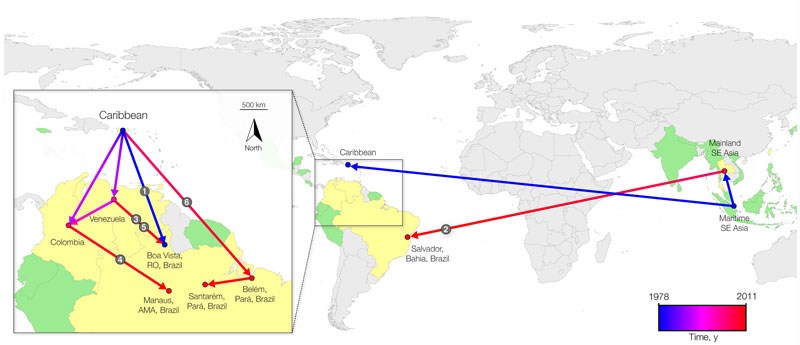Volume 18, Number 11—November 2012
Research
Phylogeography of Dengue Virus Serotype 4, Brazil, 2010–2011
Figure 3

Figure 3. . . Overview of spatiotemporal dispersal of dengue virus type 4 (DENV-4) from Southeast (SE) Asia to the Caribbean region and then to South America. Links between geographic locations represent phylogeny branches of the full genome maximum clade credibility tree, as projected by using SPREAD software (20). The blue-red gradient is coded to the arrows and depicts the relative time that has elapsed since the earliest inferred viral migration out of Southeast Asia (i.e., 1978, 95% Bayesian credible interval 1977–1980). Introductions are numbered as in Figure 1. Green indicates the presence of DENV-4 where complete genomic sequence data were available; yellow indicates sampled countries where complete genomic sequence data were available; gray, indicates no genomic data available; and circles indicate sampled locations and are colored according to the earliest migration that was detected from the sink location. RO, Roraima State; AMA, Amazonas State.
References
- Gubler DJ. Dengue and dengue hemorrhagic fever: its history and resurgence as a global public health problem. In: Gubler DJ, Kuno G, eds. Dengue and dengue hemorrhagic Fever. New York: CAB International; 1997. p. 1–22.
- Lindbäck H, Lindbäck J, Tegnell A, Janzon R, Vene S, Ekdahl K. Dengue fever in travelers to the tropics, 1998 and 1999. Emerg Infect Dis. 2003;9:438–42. DOIPubMedGoogle Scholar
- World Health Organization. Dengue fever and dengue hemorrhagic fever. Geneva: the Organization; 2009.
- Ministério da Saúde/Secretara de Vigilância em Saúde MS/SVS. Dengue cases Technical report; 2009 [in Portuguese] [cited 2011 Dec 17]. http://portal.saude.gov.br/portal/arquivos/pdf/boletim_dengue_informe11maio.pdf
- Teixeira MG, Barreto ML, Costa MCN, Ferreira LDA, Vasconcelos PFC, Cairncross S. Dynamics of dengue virus circulation: a silent epidemic in a complex urban área. Trop Med Int Health. 2002;7:757–62. DOIPubMedGoogle Scholar
- Dussart P, Baril L, Petit L, Beniguel L, Quang LC, Ly S, Clinical and virological study of dengue cases and the members of their households: the multinational DENFRAME project. PLoS Negl Trop Dis. 2012;6:e1482. DOIPubMedGoogle Scholar
- Temporão JG, Penna GO, Carmo EH, Coelho GE, do Socorro Silva Azevedo R, Teixeira Nunes MR, Dengue virus serotype 4, Roraima State, Brazil. Emerg Infect Dis. 2011;17:938–40. DOIPubMedGoogle Scholar
- Osanai CH, Travassos da Rosa AP, Tang AT, do Amaral RS, Passos AD, Tauil PL. Dengue outbreak in Boa Vista, Roraima [in Portuguese]. Rev Inst Med Trop Sao Paulo. 1983;25:53–4.PubMedGoogle Scholar
- Ministério da Saúde/Secretaria de Vigilância em Saúde MS/SVS. Sempre é hora de combater a dengue [cited 2011 Dec 17]. http://www.combatadengue.com.br/
- Margulies M, Egholm M, Altman WE, Attiya S, Bader JS, Bemben LA, Genome sequencing in microfabricated high-density picolitre reactors. Nature. 2005;437:376–80.PubMedGoogle Scholar
- Katoh K, Kuma K, Toh T, Miyata T. MAFFT version 5: improvement in accuracy of multiple sequence alignment. Nucleic Acids Res. 2005;33:511–8. DOIPubMedGoogle Scholar
- Drummond AJ, Suchard MA, Xie D, Rambaut A. Bayesian phylogenetics with BEAUti and the BEAST 1.7. Mol Biol Evol. 2012;29:1969–73. DOIPubMedGoogle Scholar
- Bruen TC, Philippe H, Bryant D. A simple and robust statistical test for detecting the presence of recombination. Genetics. 2006;172:2665–81. DOIPubMedGoogle Scholar
- Huson DH, Bryant D. Application of phylogenetic networks in evolutionary studies. Mol Biol Evol. 2006;23:254–67. DOIPubMedGoogle Scholar
- Edwards CJ, Suchard MA, Lemey P, Welch JJ, Barnes I, Fulton TL, Ancient hybridization and an Irish origin for the modern polar bear matriline. Curr Biol. 2011;21:1251–8. DOIPubMedGoogle Scholar
- Lemey P, Rambaut A, Drummond AJ, Suchard MA. Bayesian phylogeography finds its roots. PLOS Comput Biol. 2009;5:e1000520. DOIPubMedGoogle Scholar
- Minin VN, Suchard MA. Counting labeled transitions in continuous-time Markov models of evolution. J Math Biol. 2008;56:391–412. DOIPubMedGoogle Scholar
- Drummond AJ, Ho SY, Phillips MJ, Rambaut A. Relaxed phylogenetics and dating with confidence. PLoS Biol. 2006;4:e88. DOIPubMedGoogle Scholar
- Bielejec F, Rambaut A, Suchard MA, Lemey P. SPREAD: spatial phylogenetic reconstruction of evolutionary dynamics. Bioinformatics. 2011;27:2910–2. DOIPubMedGoogle Scholar
- Talbi C, Lemey P, Suchard MA, Abdelatif E, Elharrak M, Nourlil J, Phylodynamics and human-mediated dispersal of a zoonotic virus. PLoS Pathog. 2010;6:e1001166. DOIPubMedGoogle Scholar
- O’Brien JD, Minin VN, Suchard MA. Learning to count: robust estimates for labeled distances between molecular sequences. Mol Biol Evol. 2009;26:801–14. DOIPubMedGoogle Scholar
- Allicock OM, Lemey P, Tatem AJ, Pybus OG, Bennett SN, Mueller BA, Phylogeography and population dynamics of dengue viruses in the Americas. Mol Biol Evol. 2012;29:1533–43. DOIPubMedGoogle Scholar
- Centers for Disease Control and Prevention. Dengue type 4 infections in US travelers to the Caribbean. MMWR Morb Mortal Wkly Rep. 1981;30:249–50.PubMedGoogle Scholar
- Forshey BM, Morrison AC, Cruz C, Rocha C, Vilcarromero S, Guevara C, Dengue virus serotype 4, northeastern Peru, 2008. Emerg Infect Dis. 2009;15:1815–8. DOIPubMedGoogle Scholar
- Fernández J, Vera L, Tognarelli J, Fasce R, Araya P, Villagra E, Detection of dengue virus type 4 in Easter Island, Chile. Arch Virol. 2011;156:1865–8. DOIPubMedGoogle Scholar
- Nogueira RM, Eppinghaus AL. Dengue virus type 4 arrives in the state of Rio de Janeiro: a challenge for epidemiological surveillance and control. Mem Inst Oswaldo Cruz. 2011;106:255–6.PubMedGoogle Scholar
- Shu PY, Su CL, Liao TL, Yang CF, Chang SF, Lin CC, Molecular characterization of dengue viruses imported into Taiwan during 2003–2007: geographic distribution and genotype shift. Am J Trop Med Hyg. 2009;80:1039–46.PubMedGoogle Scholar
- Lanciotti RS, Gubler DJ, Trent DW. Molecular evolution and phylogeny of dengue-4 viruses. J Gen Virol. 1997;78:2279–84.PubMedGoogle Scholar
- Dussart P, Lavergne A, Lagathu G, Lacoste V, Martial J, Morvan J, Reemergence of dengue virus type 4, French Antilles and French Guiana, 2004–2005. Emerg Infect Dis. 2006;12:1748–51. DOIPubMedGoogle Scholar
- de Souza RP, Rocco IM, Maeda AY, Spenassatto C, Bisordi I, Suzuki A, Dengue virus type 4 phylogenetics in Brazil 2011: looking beyond the veil. PLoS Negl Trop Dis. 2011;5:e1439. DOIPubMedGoogle Scholar
- Holmes EC. The evolutionary history and phylogeography of human viruses. Annu Rev Microbiol. 2008;62:307–28. DOIPubMedGoogle Scholar
- Rambaut A, Pybus OG, Nelson MI, Viboud C, Taubenberger JK, Holmes EC. The genomic and epidemiological dynamics of human influenza A virus. Nature. 2008;453:615–9. DOIPubMedGoogle Scholar